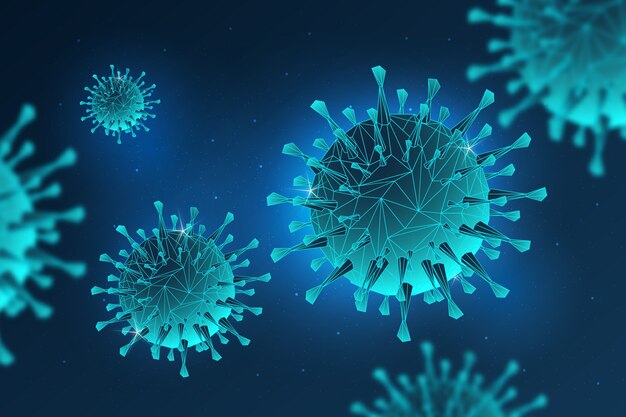Learn everything about rhinovirus, the main cause of the common cold. Discover its transmission, symptoms, and preventive measures to manage and reduce the impact of this contagious virus.
Introduction
Rhinovirus is the leading cause of the common cold and is a highly contagious virus that belongs to the Picornaviridae family. Although commonly associated with mild illnesses, rhinovirus infections can cause significant discomfort, including a sore throat, congestion, and sneezing. Its ability to survive and thrive at cooler temperatures, such as those found in the nasal passages, makes it particularly adept at spreading, especially during colder months. The virus spreads rapidly in populated environments, primarily through airborne droplets or by touching contaminated surfaces. By understanding how rhinovirus spreads and how to prevent it, we can mitigate its impact.
Structure and Characteristics of Rhinovirus
Rhinovirus is a small, non-enveloped virus with a single-stranded RNA genome. Its structure allows it to efficiently invade the cells of the human respiratory tract, where it replicates and spreads quickly. Unlike some other viruses, rhinovirus is remarkably resilient in lower temperatures, which is why it tends to infect the nasal cavity rather than the lungs. Moreover, it has over 160 different serotypes, making it difficult for the immune system to recognize and fight each variation, leading to recurrent infections. These unique structural characteristics enable rhinovirus to remain a persistent viral agent in human populations.
How Rhinovirus Spreads
The rhinovirus spreads through two main transmission methods: airborne droplets and surface contact. When an infected individual coughs or sneezes, they release viral particles into the air, which can then be inhaled by others nearby. Additionally, these droplets may land on surfaces such as doorknobs or countertops. When others touch these contaminated surfaces and then touch their face, they can inadvertently introduce the virus into their system. The virus can survive on surfaces for several hours, making it highly contagious in public spaces. Consequently, prevention strategies must focus on both respiratory hygiene and frequent hand washing.
Common Symptoms of Rhinovirus Infection
The symptoms of a rhinovirus infection are often mild but can vary in severity. Common signs include a runny nose, nasal congestion, sore throat, and sneezing. These symptoms typically appear within one to three days after exposure to the virus. Some individuals may also experience headaches, body aches, and a mild fever, although these symptoms are less common. Rhinovirus infections are usually self-limiting and resolve within a week. However, in individuals with compromised immune systems, the elderly, or young children, symptoms can be more pronounced, and complications such as bronchitis or sinus infections may arise.
Rhinovirus vs. Other Respiratory Viruses
Rhinovirus is often mistaken for other respiratory viruses such as influenza or respiratory syncytial virus (RSV). While these viruses share similar symptoms, they differ in severity and the complications they cause. For example, influenza tends to cause more systemic symptoms like muscle aches and fever, while RSV is a major concern for infants and can lead to severe lower respiratory infections. Rhinovirus, on the other hand, primarily affects the upper respiratory tract and is less likely to cause complications in healthy individuals. Understanding these differences is crucial in diagnosing and managing respiratory infections appropriately.

The Immune System’s Response to Rhinovirus
When rhinovirus enters the body, the immune system immediately reacts to eliminate the infection. The body produces antibodies specific to the serotype of the virus, which helps clear the infection over time. However, because there are many different serotypes of rhinovirus, a person can become infected multiple times throughout their life. Additionally, the immune system’s response can sometimes contribute to symptoms, such as nasal congestion, as the body produces inflammation to combat the virus. This immune response is key to clearing the virus but also plays a role in the uncomfortable symptoms associated with rhinovirus infections.
Rhinovirus in Vulnerable Populations
While rhinovirus infections are generally mild, certain populations are at greater risk of severe illness. For example, individuals with asthma or chronic obstructive pulmonary disease (COPD) are more likely to experience exacerbations due to a rhinovirus infection. Children, whose immune systems are still developing, can also be more susceptible to complications such as ear infections or sinusitis. Additionally, older adults and individuals with weakened immune systems may experience prolonged illness and an increased risk of developing secondary bacterial infections. In these groups, preventing and managing rhinovirus infections is particularly important to reduce complications.
Diagnosing Rhinovirus Infections
Diagnosing a rhinovirus infection is usually based on the patient’s symptoms, as specific laboratory tests are not typically required for mild cases. However, in certain situations, such as in hospitals or for research purposes, tests such as polymerase chain reaction (PCR) can be used to identify the presence of rhinovirus. These tests are highly sensitive and can detect the virus even in small quantities. Although a diagnosis of rhinovirus is often not essential for treatment, in some cases, distinguishing between rhinovirus and other respiratory infections can help guide treatment decisions, particularly in vulnerable populations.
Treatment Options for Rhinovirus
There is no specific antiviral treatment for rhinovirus. Instead, management focuses on relieving symptoms while the body clears the infection. Over-the-counter medications, such as decongestants and pain relievers, can help alleviate discomfort. Additionally, staying hydrated, getting plenty of rest, and using saline nasal sprays can help reduce nasal congestion and ease symptoms. In some cases, using a humidifier may also help by keeping nasal passages moist. While antibiotics are not effective against viral infections like rhinovirus, they may be prescribed if a secondary bacterial infection, such as sinusitis, develops.
Preventing Rhinovirus Infections
Preventing the spread of rhinovirus is key to reducing the incidence of common colds and limiting the virus’s impact on public health. One of the most effective preventive measures is regular hand washing with soap and water, as this helps remove any viral particles that may be on the hands. Avoiding close contact with infected individuals, especially in crowded environments, is also crucial. Furthermore, disinfecting commonly touched surfaces, such as phones, door handles, and countertops, can help prevent the virus from spreading. By practicing these preventive strategies, individuals can reduce their risk of contracting rhinovirus.
Rhinovirus and Asthma Exacerbations
For individuals with asthma, rhinovirus infections can trigger asthma exacerbations, leading to more severe respiratory symptoms such as wheezing, shortness of breath, and chest tightness. The inflammation caused by the immune system’s response to rhinovirus can narrow the airways, making it more difficult for individuals with asthma to breathe. Managing asthma symptoms during a rhinovirus infection is important and may require the use of inhalers or other asthma medications. In some cases, healthcare providers may recommend preventive measures, such as increased use of maintenance inhalers during cold and flu season, to reduce the risk of exacerbations.
Rhinovirus in Children
Children are particularly susceptible to rhinovirus infections, as their immune systems are still developing, and they are often exposed to the virus in daycare or school settings. While most rhinovirus infections in children are mild, they can sometimes lead to complications such as ear infections or sinusitis. Parents can help prevent the spread of rhinovirus by encouraging good hygiene practices, such as frequent hand washing and teaching children to cover their mouths and noses when they cough or sneeze. Ensuring children get plenty of rest and stay hydrated can also help them recover more quickly from a rhinovirus infection.

The Role of Environmental Factors
Environmental factors, such as cold weather and dry air, can increase the risk of rhinovirus transmission. The virus thrives in cooler temperatures, which is why rhinovirus infections are more common in the fall and winter months. Additionally, spending more time indoors in close proximity to others during these months can facilitate the spread of the virus. Dry air can also dry out the mucous membranes in the nasal passages, making it easier for the virus to enter the body. Using a humidifier in indoor spaces and ensuring proper ventilation can help reduce the risk of infection during colder months.
Complications from Rhinovirus Infections
Although rhinovirus infections are typically mild, complications can occur, particularly in individuals with pre-existing respiratory conditions. For example, rhinovirus can exacerbate chronic conditions such as asthma or COPD, leading to more severe respiratory symptoms. In some cases, rhinovirus infections can lead to secondary bacterial infections, such as sinusitis or ear infections. In rare instances, rhinovirus may cause lower respiratory tract infections, such as bronchitis or pneumonia, especially in vulnerable populations. Early management of symptoms and seeking medical attention when necessary can help prevent these complications from becoming more severe.
Rhinovirus and the Common Cold
Rhinovirus is responsible for the majority of common cold cases, making it one of the most prevalent respiratory viruses in the world. Although the common cold is typically mild and self-limiting, it can cause significant discomfort and inconvenience. Symptoms such as a runny nose, sore throat, and sneezing are characteristic of the common cold, and while there is no cure, symptom management can help alleviate discomfort. Understanding the link between rhinovirus and the common cold is essential for developing strategies to prevent and manage these widespread infections.
The Impact of Rhinovirus on Public Health
Rhinovirus infections have a significant impact on public health, particularly in terms of healthcare costs and lost productivity. Each year, millions of individuals experience rhinovirus infections, leading to numerous doctor visits, missed days of work or school, and the overuse of antibiotics for secondary infections. Additionally, rhinovirus infections can place a strain on healthcare systems, especially during peak cold and flu seasons. Public health initiatives that focus on preventive measures, such as promoting good hygiene and vaccination for secondary infections, can help reduce the burden of rhinovirus on healthcare systems and society as a whole.
Research on Rhinovirus
Ongoing research on rhinovirus aims to better understand its structure, transmission, and the immune system’s response to infection. Scientists are also investigating potential treatments and vaccines that could prevent rhinovirus infections or reduce their severity. While developing a vaccine for rhinovirus has been challenging due to the large number of serotypes, advances in immunology and virology may eventually lead to effective interventions. Additionally, researchers are exploring new antiviral medications that could target the virus more effectively than current treatments. Continued research is crucial for developing strategies to combat rhinovirus and reduce its impact on global health.
Rhinovirus and Seasonal Trends
Rhinovirus infections tend to follow a seasonal pattern, with the highest incidence occurring in the fall and winter months. The cooler temperatures and increased time spent indoors contribute to the spread of the virus during these seasons. Additionally, the immune system may be more vulnerable during colder months, as individuals are exposed to other respiratory viruses, such as influenza, at the same time. Understanding these seasonal trends can help individuals take preventive measures, such as boosting their immune systems through proper nutrition and hygiene practices, to reduce the risk of rhinovirus infection during peak seasons.
The Future of Rhinovirus Prevention
As research on rhinovirus continues, new strategies for preventing and managing infections are likely to emerge. Improved diagnostic tools, antiviral medications, and possibly even vaccines could help reduce the prevalence of rhinovirus infections in the future. Additionally, public health campaigns that promote good hygiene and respiratory etiquette will remain crucial in limiting the spread of the virus. While rhinovirus is unlikely to be eradicated due to its many serotypes and ease of transmission, advances in science and medicine will undoubtedly lead to better management and prevention strategies in the coming years.
Conclusion
Rhinovirus may be responsible for the common cold, but its impact goes beyond mere inconvenience. Understanding its transmission, symptoms, and preventive measures can help reduce its spread, especially among vulnerable populations. By staying informed and practicing good hygiene, individuals can protect themselves and others from rhinovirus infections. With ongoing research and public health initiatives, we can continue to mitigate the effects of this pervasive virus.
Read also: molluscum contagiosum Treating, and Preventing the Skin Infection





